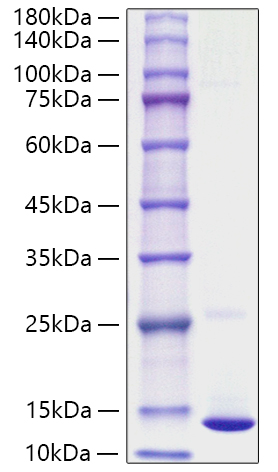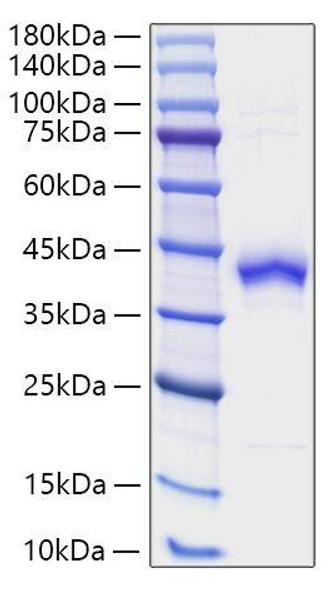Description
Recombinant Human S100-A10 Protein
The Recombinant Human S100-A10 Protein is a biologically active recombinant protein that plays a significant role in various cellular processes and signaling pathways in human biology. This protein is widely employed in immunological research, cell biology studies, protein-protein interaction analyses, and therapeutic development, providing researchers with a reliable tool for investigating S100-A10 function and its implications in health and disease.
This product (SKU: RPCB1742) is produced using E. coli and features a C-6His tag for convenient detection and purification. The protein exhibits a calculated molecular weight of 12.04 kDa with an observed molecular weight of 12-15 kDa under denaturing conditions, achieving ≥ 90% as determined by SDS-PAGE., ensuring exceptional quality and consistency for research applications.
Key Features
| High Purity by Affinity Chromatography | |
| Mammalian & Bacterial Expression Systems | |
| High lot-to-lot consistency via strict QC |
| Product Name: | Recombinant Human S100-A10 Protein |
| SKU: | RPCB1742 |
| Size: | 10 μg , 20 μg , 50 μg , 100 μg |
| Reactivity: | Human |
| Synonyms: | 42C, P11, p10, GP11, ANX2L, CAL1L, CLP11, Ca[1], ANX2LG;S100A10 |
| Tag: | C-6His |
| Expression Host: | E. coli |
| Calculated MW: | 12.04 kDa |
| Observed MW: | 12-15 kDa |
| Gene ID: | 6281 |
| Protein Description: | High quality, high purity and low endotoxin recombinant Recombinant Human S100-A10 Protein (RP01677LQ), tested reactivity in E. coli and has been validated in SDS-PAGE.100% guaranteed. |
| Endotoxin: | < 0.1 EU/μg of the protein by LAL method. |
| Purity: | ≥ 90% as determined by SDS-PAGE. |
| Formulation: | Supplied as a 0.22 μm filtered solution in 20mM Tris 10% Glycerol,PH8.5 |
| Storage: | Store at -70℃. This product is stable at ≤ -70℃ for up to 1 year from the date of receipt. For optimal storage, aliquot into smaller quantities after centrifugation and store at recommended temperature. Avoid repeated freeze-thaw cycles. |
S100A10 functions as a linker tethering certain transmembrane proteins to annexin A2 thereby assisting their traffic to the plasma membrane and/or their firm anchorage at certain membrane sites.







